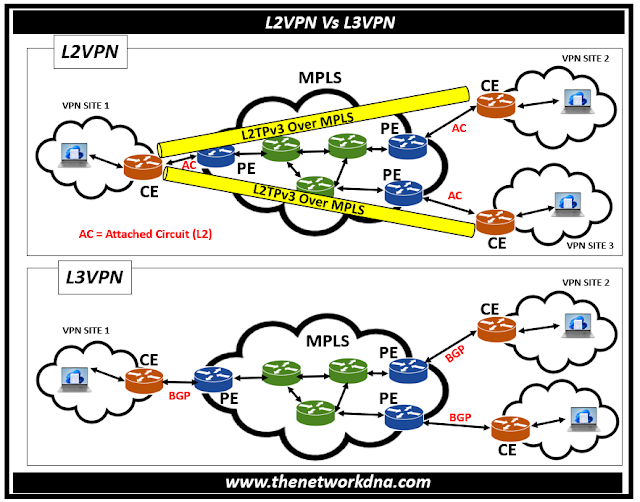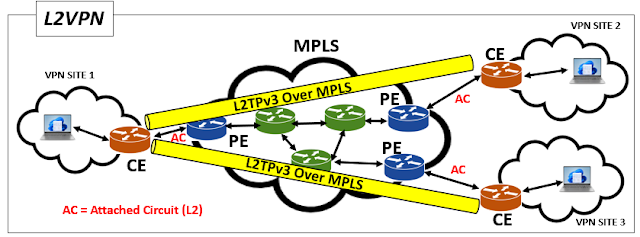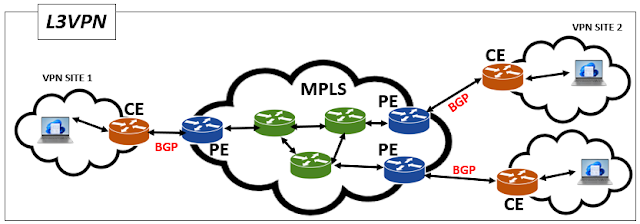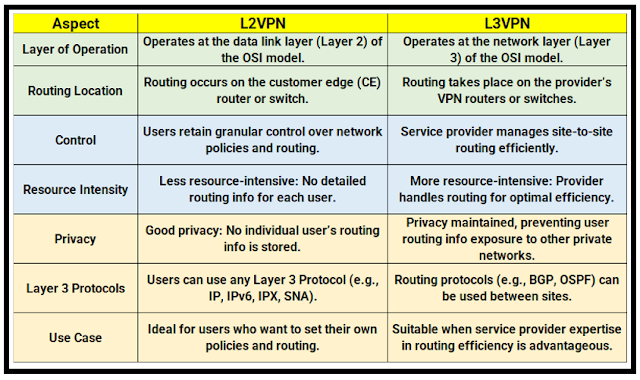Understanding the Basics: L2VPN vs L3VPN
Understanding the Basics: L2VPN vs L3VPN
It is important to understand the difference between Layer 2 VPN and Layer 3 VPN services when traffic is going through the Service provider's MPLS network.
Fig 1.1- Understanding the Basics: L2VPN vs L3VPN
Layer 2 VPN (L2 VPN)
A Layer 2 VPN creates private connections between two sites in an IP or MPLS network, replicating a physical sub-network. Coordination between the service provider and customer is necessary while establishing an L2VPN network. The service provider connects Layer 2 devices and the customer uses the service provider's data link resources to create their own network.
L2VPN services do not require information about the customer's network L3 routes. This helps ensure consumer privacy while using the resources of the service provider to construct the network.
Layer 2 VPNs combine Layer 2 traffic, including Ethernet, Frame Relay, asynchronous transfer mode (ATM), High Level Data Link Control (HDLC), and Point-to-Point Protocol (PPP), across an IP/MPLS network.
Layer 3 VPN (L3 VPN)
In a Layer 3 VPN, the service provider will engage in routing alongside the consumer. The customer will run OSPF, EIGRP, BGP, or any other routing protocol with the service provider; these routes can be shared with other customer sites.
Routing information is typically shared with the service provider (MPLS), and routing information from one customer is completely segregated from that of other customers and tunneled over the service provider's MPLS network.
A Layer 3 VPN distinguishes between VPN routes by using a unique route target. For example, RT allows numerous clients to share routes in a shared service network. Each VPN route can include one or more RTs.
Layer 3 VPN (L3 VPN) Vs Layer 2 VPN (L2 VPN)
Lets talk about the difference between Layer 2 and Layer 3 VPN technologies. L2VPNs give users more control, but L3VPNs use provider experience to optimize routing.
In the Layer 2 scenario, there is no routing interaction between the customer and service provider. In the L3VPN instance, the CE and PE routers can swap routes.
In the Layer 2 scenario, the customer can use any Layer 3 protocol between sites. The SP network is only carrying Layer 2 frames and is therefore unaware of the Layer 3 protocol that is in use. Although IP is widely used in enterprise networks, non-IP protocols such as IPX and SNA are also commonly used. This would rule out the use of a Layer 3 VPN to carry that type of communication.
In the Layer 2 instance, each CE and the related PE require several (logical) interfaces, one for each remote CE to which it must link.
For example, if the CE routers are fully meshed and there are ten CE routers in total, each CE requires nine interfaces (DLCIs, VCs, or VLANs, depending on the media type) to the PE, each of which connects to one of the remote CE routers. In the Layer 3 VPN instance, one connection between each CE and the local PE is enough.
- The Battle of the Data Transports: Ethernet vs MPLS
- Decoding VRF Vs VRF Lite
- MPLS LDP Basic Concepts
- MPLS LDP Loop Detection
- TTL Processing in MPLS
- Basics: How to configure MPLS and MPLS Traffic Engineering
- Do you know about VRF lite in MPLS networks ?
- Introduction to VRF(Virtual Routing forwarding)
- Part 4: MPLS Forwarding Operations (LDP Vs RSVP)
- A brief about MPLS Header & Label











